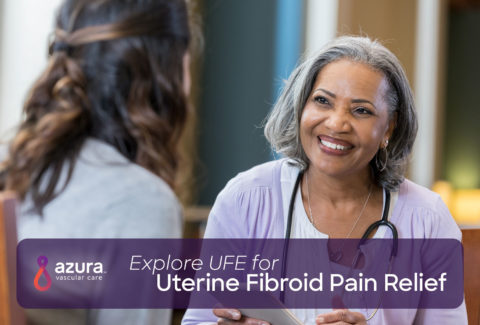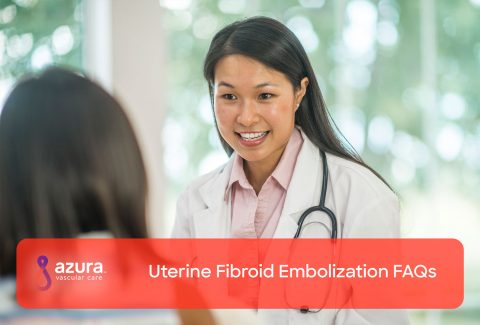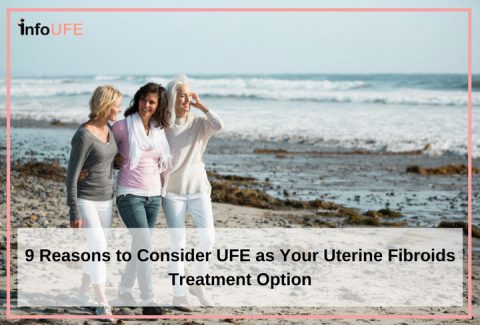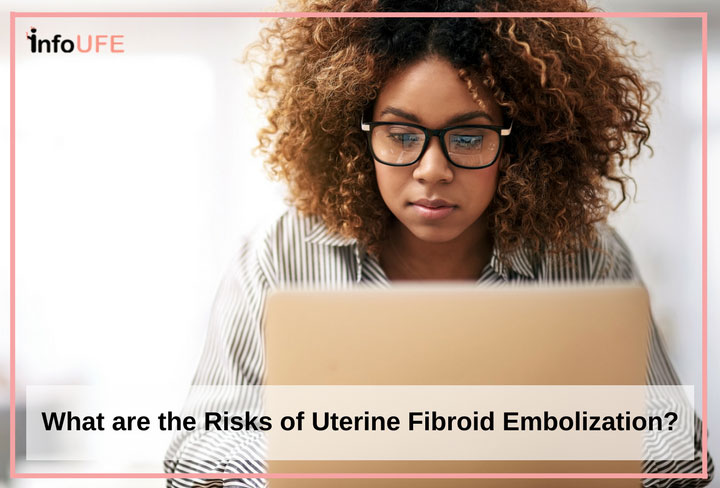
Any medical procedure is going to come with some risk. Uterine fibroid embolization (UFE), sometimes referred to as uterine artery embolization (UAE) is a minimally invasive alternative to uterine fibroid surgery. The UFE procedure involves the injection of small beads into the uterine arteries, blocking blood flow to the fibroids. Whether you’re considering uterine fibroid surgery or UFE, it’s important to weigh the risks associated with each treatment option. For some women, the fibroid embolization risks appear to be minimal compared with surgery. For example, uterine fibroid embolization recovery time is much shorter with a lower risk of bleeding compared to surgery.
RELATED: 10 Questions to ask Your Interventional Radiologist About Fibroids and UFE
Risks of Uterine Fibroid Embolization
It is important to be knowledgeable and aware of the different risks for any procedure you are considering as a treatment for your uterine fibroids. Typically, most risks are confined to a window of time, such as during the procedure, early after the procedure, within the first month, and after the first month. Below is a more in depth explanation of the various risks to be aware of when undergoing a UFE procedure.
During the Procedure
Potential risks during the UFE procedure are related to the use of x-rays, contrast dye, and catheterization. Once the catheter has been inserted into your blood vessel, there is a slight risk of a catheter-related injury, although rare, which can lead to a few different issues, including hematoma, thrombosis, and pseudo-aneurysm.
- Hematoma – The abnormal development of a pocket of blood outside of the blood vessel that has been punctured.
- Thrombosis – The formation of a blood clot within a blood vessel.
- Pseudo-aneurysm – A small tear in the blood vessel wall that leads to blood leaking just outside of the vessel and is contained in the surrounding tissues.[i]
 Radiation is an essential part of UFE. Fluoroscopy, a type of X-ray technology is used during uterine fibroid embolization to visualize, in real time, the path the catheter takes into the arteries that supply blood to the fibroids. With this approach, catheter placement and embolization are safer, but come with some unique risks such as radiation exposure or, in a small number of people, an allergic reaction to the contrast dye used.
Radiation is an essential part of UFE. Fluoroscopy, a type of X-ray technology is used during uterine fibroid embolization to visualize, in real time, the path the catheter takes into the arteries that supply blood to the fibroids. With this approach, catheter placement and embolization are safer, but come with some unique risks such as radiation exposure or, in a small number of people, an allergic reaction to the contrast dye used. - Radiation Exposure – While every attempt is made to limit the exposure to radiation, by virtue of the focus on the pelvic organs for UFE, the ovaries are exposed to some radiation. A skilled interventional radiologist will be able to limit this exposure as much as possible.[ii]
- Contrast Dye – In order to improve the visibility of internal structures, a special dye that’s detectable with x-rays is used during the UFE procedure. This dye is safe for most people, but should not be given to those who have a known allergy to contrast, are on certain medications, or are diagnosed with diabetes or chronic kidney disease.[iii]
Early After the Procedure
During the first 30 days after the procedure, you should be aware of your body’s response to the embolization. Some patients experience pain, nausea, fatigue, fever, infection, or vaginal discharge, but typically these are not severe and resolve on their own.
- Pain – Uterine cramping commonly occurs and is most severe within the first 24 hours after the procedure.
- Nausea, Fatigue, Low-grade Fever – Any of these symptoms may
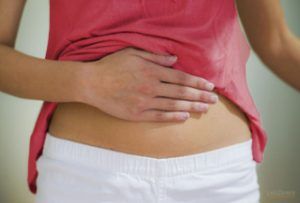 occur 4 – 5 days after the procedure due to post-embolization syndrome. They’re generally related to the release of chemicals by the treated fibroids.
occur 4 – 5 days after the procedure due to post-embolization syndrome. They’re generally related to the release of chemicals by the treated fibroids. - Infection – Can develop and may be accompanied by vaginal discharge and fever for more than 5 days after the procedure.
- Vaginal Discharge – Commonly occurs and resolves within a few days.[iv]
RELATED: What To Expect When Recovering From Uterine Fibroid Embolization
One Month or More After the Procedure
It is possible that women can have residual complications and related issues more than a month post-procedure. You should alert your doctor if you think you’re experiencing any of the following conditions.
- Fibroid Expulsion – Less than 10% of women will experience fibroid expulsion, which is when a fibroid will pass from the vagina. This is more likely to occur with fibroids that are at or just below the lining of the uterus. Signs of expulsion would include pain and vaginal discharge. Depending upon the size of the fibroid, surgery may be needed to complete the removal of these, but this is rare.[v]
- Fertility – The impact on future fertility is uncertain. Women have had successful pregnancies after UFE, but it is important to discuss any plans for future pregnancies with an interventional radiologist during the consultation.[v]
- Menopause – UFE can affect the hormones that control the menstrual cycle. The cessation of menstruation, or menopause, can occur in 1-2% of women and is more likely to occur in women over the age of 45.[v-vi]
- Need for Future Procedures – While UFE is effective in the treatment of uterine fibroids, new fibroids can grow because the procedure does not involve the complete removal of the uterus. Young women are more likely to need future procedures, mainly because menopause is further away.[v] However, even with the risk of needing additional procedures, women tend to be satisfied with the results obtained by UFE.[vii]
If you have concerns about whether uterine fibroid embolization is right for you, or are worried about a particular risk, the best thing to do is set up a consultation with an interventional radiologist to discuss your medical history and plans for the future.
Sources:
i http://www.mayoclinic.org/tests-procedures/cardiac-catheterization/expert-answers/pseudoaneurysm/faq-20058420
ii Firouznia, K., et al., Uterine artery embolization for treatment of symptomatic fibroids: a review of the evidence. Iran Red Cres Med J, 2013. 15(12): p. 1-6.
iii Andreucci, M, et al., Acute kidney injury by radiographic contrast medium: pathogenesis and prevention. Biomed Res Int, 2014. 362725. http://doi.org/10.1155/2014/362725.
iv Khan, A.T., Shehmar, M., and Gupta, J.K., Uterine fibroids: current perspectives. Int J Womens Health, 2014. 6: p. 95-114.
v Mara, M. and K. Kubinova, Embolization of uterine fibroids from the point of view of the gynecologist: pros and cons. Int J Womens Health, 2014. 6: p. 623-9.
vi Tomislav, S., et al., Uterine Artery Embolization as Nonsurgical Treatment of Uterine Myomas. ISRN Obstet Gynecol, 2011. 2011:489281. doi: 10.5402/2011/489281. Epub 2011 Nov 23.
vii van der Kooij, S.M., et al., Uterine artery embolization vs hysterectomy in the treatment of symptomatic uterine fibroids: 5-year outcome from the randomized EMMY trial. Am J Obstet Gynecol, 2010. 203(2): p. 105 e1-13.
